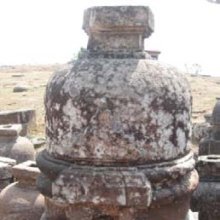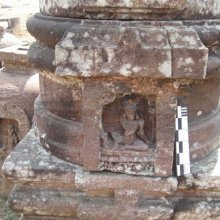Maharajalilasana, Mahārājalīlāsana, Maharajalila-asana: 1 definition
Introduction:
Maharajalilasana means something in Hinduism, Sanskrit. If you want to know the exact meaning, history, etymology or English translation of this term then check out the descriptions on this page. Add your comment or reference to a book if you want to contribute to this summary article.
Images (photo gallery)
In Hinduism
Shilpashastra (iconography)
Source: Shodhganga: The significance of the mūla-beras (śilpa)Mahārājalīlāsana (महाराजलीलासन) or Rājalīlāsana refers to a type of Āsana (sitting poses), according to Ganapati Sthapati in his text Ciṟpa Cennūl, as defined according to texts dealing with śilpa (arts and crafs), known as śilpaśāstras.—In the [Mahārājalīlāsana] posture, with the right leg held vertically and the left folded flat, if the right elbow is placed on the right knee with the hand gracefully bent down or held close to the chest, and the left hand supported on the ground, with the body arched in a relaxed manner, it is called mahārājalīlā-āsana. Buddha and Siṃhanātha images are usually fashioned in this posture.

Shilpashastra (शिल्पशास्त्र, śilpaśāstra) represents the ancient Indian science (shastra) of creative arts (shilpa) such as sculpture, iconography and painting. Closely related to Vastushastra (architecture), they often share the same literature.
See also (Relevant definitions)
Partial matches: Asana, Maharaja.
Full-text: Rajalilasana.
Relevant text
Search found 4 books and stories containing Maharajalilasana, Mahārājalīlāsana, Maharajalila-asana, Mahārāja-līlāsana, Mahārājalīlā-āsana, Maharaja-lilasana; (plurals include: Maharajalilasanas, Mahārājalīlāsanas, asanas, līlāsanas, āsanas, lilasanas). You can also click to the full overview containing English textual excerpts. Below are direct links for the most relevant articles:
Jainism in Odisha (Orissa) (by Ashis Ranjan Sahoo)
Ambika images (Koraput) < [Chapter 3: Survey of Jaina Antiquities in Odisha]
Jaina Sculptures at Achutrajpur < [Chapter 3: Survey of Jaina Antiquities in Odisha]
Jaina Remains at Jamunda Village < [Chapter 3: Survey of Jaina Antiquities in Odisha]
Vietnamese Buddhist Art (by Nguyen Ngoc Vinh)
2. Avalokitesvara images in Champa < [Chapter 3 - Unifying factors of the Avalokitesvara Images in South Vietnam and South East Asia]
Stupas in Orissa (Study) (by Meenakshi Chauley)
Stylised Form of the Frames of the Niches < [Chapter 4]
Minor Structural Stupas at Ratnagiri < [Chapter 4]
Drum slabs at at Ratnagiri < [Chapter 4]
Jain Remains of Ancient Bengal (by Shubha Majumder)
Śāsanadevīs or Yakṣiṇīs from Ancient Bengal < [Chapter 6 - Iconographic Study of Jaina Sculptural Remains]


